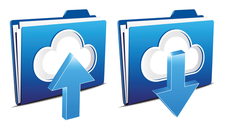Lean and simple cloud storage alternative, simpleDrive
Plain and Simple

© Lead Image © roywylam, 123RF.com
If you value data security and privacy, you might want to build your own cloud storage. SimpleDrive offers a workable alternative to this time-consuming project.
Many enterprises compete for the job of storing your data in the cloud – Google Drive, Apple iCloud, Microsoft OneDrive (SkyDrive), Dropbox, Box, Copy – and all of these services offer a good deal of performance for very little money. The basic offerings with storage sizes up to 5GB are often even free. Without a doubt, though, the user is not just the customer, but also the product.
For this reason, users who set store in data protection and privacy often choose to use open source solutions such as ownCloud [1] or Seafile [2], which are already in use in many companies and educational organizations. The open source alternatives run natively on hosted web space or a Raspberry Pi.
SimpleDrive [3] offers another alternative to the major commercial vendors. The program, written in PHP, needs a web server with matching support and MySQL. You can rent the web space for a small amount or keep your data at home, at the office, or on your own server with an SSL certificate: This ensures that any data you store on simpleDrive is encrypted during transmission over the Internet.
[...]
Buy this article as PDF
(incl. VAT)
Buy Linux Magazine
Subscribe to our Linux Newsletters
Find Linux and Open Source Jobs
Subscribe to our ADMIN Newsletters
Support Our Work
Linux Magazine content is made possible with support from readers like you. Please consider contributing when you’ve found an article to be beneficial.

News
-
Parrot OS Switches to KDE Plasma Desktop
Yet another distro is making the move to the KDE Plasma desktop.
-
TUXEDO Announces Gemini 17
TUXEDO Computers has released the fourth generation of its Gemini laptop with plenty of updates.
-
Two New Distros Adopt Enlightenment
MX Moksha and AV Linux 25 join ranks with Bodhi Linux and embrace the Enlightenment desktop.
-
Solus Linux 4.8 Removes Python 2
Solus Linux 4.8 has been released with the latest Linux kernel, updated desktops, and a key removal.
-
Zorin OS 18 Hits over a Million Downloads
If you doubt Linux isn't gaining popularity, you only have to look at Zorin OS's download numbers.
-
TUXEDO Computers Scraps Snapdragon X1E-Based Laptop
Due to issues with a Snapdragon CPU, TUXEDO Computers has cancelled its plans to release a laptop based on this elite hardware.
-
Debian Unleashes Debian Libre Live
Debian Libre Live keeps your machine free of proprietary software.
-
Valve Announces Pending Release of Steam Machine
Shout it to the heavens: Steam Machine, powered by Linux, is set to arrive in 2026.
-
Happy Birthday, ADMIN Magazine!
ADMIN is celebrating its 15th anniversary with issue #90.
-
Another Linux Malware Discovered
Russian hackers use Hyper-V to hide malware within Linux virtual machines.

